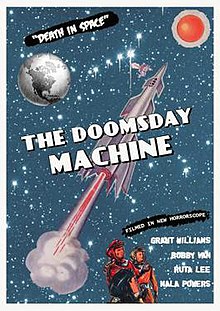Doomsday Machine (film)
| Doomsday Machine | |
|---|---|
 | |
| Directed by | Herbert J. Leder Harry Hope Lee Sholem |
| Written by | Stuart J. Byrne |
| Produced by | Harry Hope |
| Starring | Denny Miller Ruta Lee Grant Williams Mala Powers Henry Wilcoxon Bobby Van |
| Cinematography | Stanley Cortez |
| Distributed by | Cine-Find |
Release date |
|
Running time | 83 minutes |
| Country | United States |
| Language | English |
| Budget | $700 000[citation needed] |
Doomsday Machine, also known as Escape from Planet Earth (video title), is an American science fiction film filmed in 1967 but completed without the original cast or sets in 1972.[1]
Plot
A spy (Essie Lin Chia) discovers that the Chinese government has created a doomsday device (the "key" to which, "only Chairman Mao has") capable of destroying the Earth and it will be activated in 72 hours. Soon after, Astra – a two year return mission to Venus by the United States Space Program – has its time of launch speeded up and half of the male flight crew are replaced by women shortly before take-off, including one Russian. Shortly before blastoff military alerts are put into effect.
After leaving Earth, the seven crew members of Astra deduce that they have been put together to restart the human race should the Chinese activate their device. Shortly after this, the device goes off and Earth is destroyed.
As Astra continues to Venus, the crew realizes that a safe landing on Venus is impossible unless the crew is reduced to three. One of the crew members tries to rape another, at which point she accidentally gets them both blown out of an airlock.
Two more crew-members – an American astronaut and the female Russian – are lost as they head out to repair a fault with the spaceship. However, they notice another spacecraft nearby and jump to it. The second craft proves to be a lost Soviet ship that disappeared piloted by a close friend of the Russian crew member. Though its pilot is dead, the astronauts successfully power up the Soviet ship. Before the two ships can rendezvous, contact with Astra is lost.
A disembodied voice cuts in, claiming to be the collective consciousness of the Venusian population. The voice informs the survivors (whom the Venusians refer to as the "Last of Man") in the Russian ship that Astra no longer exists (presumably destroyed somehow by the telepathic Venusians), and that no humans (due to their "self-destructive" potential) will be allowed to reach Venus. It gives a cryptic message regarding the prospect of starting new life in a "very strange and very great" place, somewhere far "beyond the rim of the universe", before the movie abruptly concludes.
Production
Production of Doomsday Machine began in 1967 under Herbert J. Leder's direction[2] under the titles Armageddon 1975 and Doomesday Plus Seven. Production stopped on the film before it was completed (presumably due to production funding problems), but the rights to the film were eventually purchased and completed in 1972, albeit without the original cast members or scene sets.
Sloppy production standards have made the film a favorite for buffs of bad cinema. Excessive use of stock footage includes real (but badly degraded) NASA rocket footage, special effects shots from David L. Hewitt's (who also worked on the film) The Wizard of Mars (1965), Gorath (1962) and other disparate sources, leading to numerous continuity errors. Among persistent errors is the external appearance of the Astra, which inexplicably changes throughout the film. The painfully protracted last segment of the story – with an American and Russian astronaut boarding a derelict Soviet spacecraft – was obviously shot after the unfinished principal photography without either one of the characters' original actors. They stay in their spacesuits, which are noticeably different from those seen in the immediately preceding scenes and whose helmets have mysteriously become opaque, concealing their faces; their voices are completely different from that heard in the rest of the film, the Russian no longer even having an accent.
Reception
The audience approval rating on Rotten Tomatoes is a measly 7%, based on 187 votes. Bill Gibron of PopMatters called it an "MST3K Season 4 level challenge. At one point during the Cinematic Titanic take on the film, Frank Conniff states exasperatedly that this experience is like 'watching someone else watching Manos: The Hands of Fate".
In popular culture
- The film was the second film riffed in the Cinematic Titanic series.
- This film was reviewed by the Nostalgia Critic on Best of TGWTG Volume 3.
References
- ^ contact@hkcinemagic.com (2007-03-02). "HKcinemamagic.com". Hkcinemagic.com. Retrieved 2013-07-29.
- ^ "Stanley Cortez". Cinematographers.nl. Retrieved 2013-07-29.
External links
- Doomsday Machine at IMDb
- Doomsday Machine is available for free viewing and download at the Internet Archive
- http://www.rottentomatoes.com/m/doomsday-machine/
